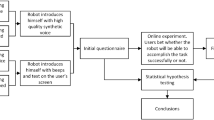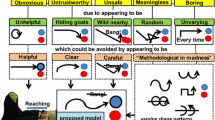Abstract
The motion of a humanoid robot is one of the most intuitive communication channels for human-robot interaction. Previous studies have presented related knowledge to generate speech-based motions of virtual agents on screens. However, physical humanoid robots share time and space with people, and thus, numerous speechless situations occur where the robot cannot be hidden from users. Therefore, we must understand the appropriate roles of motion design for a humanoid robot in many different situations. We achieved the target knowledge as motion-design guidelines based on the iterative findings of design case studies and a literature review. The guidelines are largely separated into two main roles for speech-based and speechless situations, and the latter can be further subdivided into idling, observing, listening, expecting, and mood-setting, all of which are well-distributed by different levels of intension. A series of experiments proved that our guidelines help create preferable motion designs of a humanoid robot. This study provides researchers with a balanced perspective between speech-based and speechless situations, and thus they can design the motions of a humanoid robot to satisfy users in more acceptable and pleasurable ways.













Similar content being viewed by others
References
Argyle M (1975) Bodily communication. Methuen, London
Breazeal C (2004) Social interactions in HRI: the robot view. IEEE Trans Syst Man Cybern 34(2):181–186
Breazeal C, Scassellati B (2000) Infant-like social interactions between a robot and a human caregiver. Adapt Behav 8(1):49–74
Breazeal C, Kidd D, Thomaz A, Hoffman G, Berlin M (2005) Effects of nonverbal communication on efficiency and robustness in human-robot teamwork. In: Proc IROS’05, pp 708–713
Breemen V (2004) Bringing robots to life: applying principles of animation to robots. In: Proc shaping human-robot interaction workshop, CHI’04
Brooks A, Arkin R (2006) Behavioral overlays for non-verbal communication expression on a humanoid robot. Auton Robots 22(1):55–74
Boudreau D (2002) Design 4U. ASU research magazine, 2002 summer: 40–43
Cassell J, Pelachaud C, Badler N, Steedman M (1994) Animated conversation: rule-based generation of facial expression, gesture & spoken intonation for multiple conversational agents. In: Proc the 21st annual conference on computer graphics and interactive techniques, pp 413–420
Cassell J, Vilhj’almsson H, Bickmore T (2001) BEAT: the behavior expression animation toolkit. In: Proc SIGGRAPH’01, pp 477–486
Duffy B (2003) Anthropomorphism and the social robot. Robot Auton Syst 42(3–4):177–190
Egges A, Molet T, Magnenat-Thalmann N (2004) Personalized real-time idle motion synthesis. In: Proc the 12th pacific graphics conference, pp 121–130
Ellenberg R, Grunberg D, Kim Y, Oh P (2009) Creating an autonomous dancing robot. In: Proc international conference on hybrid information Technology’09, pp 222–227
Foner L (1997) What’s an agent, anyway? A sociological case study. Agents memo 93-01. Agents group. MIT Media Lab, Cambridge, MA, p 199
Fong T, Nourbakhsh I, Dautenhahn K (2003) A survey of socially interactive robots. Robot Auton Syst 42(3–4):143–166
Goffman E (1963) Behavior in public space. Free Press, New York
Hall E (1966) The hidden dimension. Garden City, Doubleday
Hasanuzzaman T, Zhang V, Ampornaramveth H, Ueno H (2006) Gesture-based human-robot interaction using a knowledge-based software platform. Ind Robot, Int J 33(1):37–49
Imai M, Ono T, Ishiguro H (2003) Physical relation and expression: joint attention for human-robot interaction. IEEE Trans Ind Electron 50(4):636–643
Kendon A (1988) Sign languages of aboriginal Australia: cultural, semiotic and communicative perspectives. Cambridge University Press, Cambridge
Kipp M, Neff M, Kipp K, Albrecht I (2007) Towards natural gesture synthesis: evaluating gesture units in a data-driven approach to gesture synthesis. In: Proc international conference of intelligent virtual agents, pp 15–28
Knapp M, Hall J (1997) Nonverbal communication in human interaction, 4th edn. Harcourt Brace College Publishers, Fort Worth
Kopp S, Wachsmuth I (2000) A knowledge-based approach for lifelike gesture animation. A knowledge-based approach for lifelike gesture animation. In: Proc European conference on artificial intelligence, pp 663–667
Kozima H, Vatikiotis-Bateson E (2001) Communicative criteria for processing time/space-varying information. In: Proc IEEE international workshop on robot and human communication, pp 377–382
Lee J, Marsella S (2006) Nonverbal behavior generator for embodied conversational agents. Intell Virtual Agents 4133:243–255
Lee J, Resnick M (2009) Reading with robots: engaging children to read aloud to robots. Technical report, MIT, School of Media Arts and Sciences
Lee J, DeVault D, Marsella S, Traum D (2008) Thoughts on FML: behavior generation in the virtual human communication architecture. Presented at the first functional markup language workshop, AAMAS’08
Machotka P, Spiegel J (1982) The articulate body. Irvington Publishers, New York
Mali A (2002) On the evaluation of agent behaviors. Technical report, Department of Electrical Engineering and Computer Science, Wisconsin Univ, Milwaukee
Matsusaka Y (2008) History and current researches on building a human interface for humanoid robots. Model Commun Robots Virtual Hum 4930:109–124
Moore C, Dunham P (eds) (1995) Joint attention: its origins and role in development. Erlbaum, Hillsdale
Nakadai K, Hidai K, Mizoguchi H, Okuno H, Kitano H (2001) Real-time auditory and visual multiple-object tracking for robots. In: Proc the international joint conference on artificial intelligence, pp 1425–1432
Nehaniv C (2005) Classifying types of gesture and inferring intent. In: Proc AISB’05 symposium on robot companions, pp 74–81
Ogasawara Y, Okamoto M, Nakano Y, Nishida T (2005) Establishing natural communication environment between a human and a listener robot. In: Proc AISB symposium on conversational informatics, pp 42–51
Pelachaud C (2005) Multimodal expressive embodied conversational agents. In: Proc the 13th annual ACM international conference on multimedia, pp 683–689
Poyatos F (1976) Man beyond words. Theory and methodology of nonverbal communication. New York State English Council, Oswego
Ribeiro T, Paiva A (2012) The illusion of robotic life: principles and practices of animation for robots. In: Proc HRI’12, pp 383–390
Saerbeck M, Breemen V (2007) Design guidelines and tools for creating believable motion for personal robots. In: Proc the 16th IEEE international symposium on robot and human interactive communication, pp 386–391
Sakamoto D, Kanda T, Ono T, Kamachima M, Imai M, Ishiguro H (2005) Cooperative embodied communication emerged by interactive humanoid robots. Int J Hum-Comput Stud 62:247–265
Salvini P, Laschi C, Dario P (2010) Design for acceptability: improving robots’ coexistence in human society. Int J Soc Robot 2:451–460. doi:10.1007/s12369-010-0079-2
Suzuki K, Hikiji R, Hashimoto S (2002) Development of an autonomous humanoid robot, iSHA, for harmonized human-machine environment. J Robot Mechatron 14(5):497–505
Thomas F, Johnson O (1981) The illusion of life. Disney animation, Walt Disney productions
Young J et al (2011) Evaluating human-robot interaction focusing on the holistic interaction experience. Int J Soc Robot 3:53–67. doi:10.1007/s12369-010-0081-8
Wolf T, Rode J, Sussman J, Kellogg W (2006) Dispelling design as the ‘Black Art’ of CHI. In: Proc the SIGCHI conference on human factors in computing systems, pp 521–530
Acknowledgements
We thank Fumitaka Yamaoka, Takamasa Iio, Yusuke Okuno, and Shiga Miwa for their extensive help in making the scenario movies, and we also appreciate the technical assistance of Shunsuke Yoshida and Kazuhiko Shinozawa of ATR’s IRC Lab.
Author information
Authors and Affiliations
Corresponding author
Additional information
This work was supported by the Internship Program of Brain Korea 21 and in part supported by a Grant-in Aid for Scientific Research in Japan, KAKENHI (21118008).
Rights and permissions
About this article
Cite this article
Jung, J., Kanda, T. & Kim, MS. Guidelines for Contextual Motion Design of a Humanoid Robot. Int J of Soc Robotics 5, 153–169 (2013). https://doi.org/10.1007/s12369-012-0175-6
Accepted:
Published:
Issue Date:
DOI: https://doi.org/10.1007/s12369-012-0175-6




